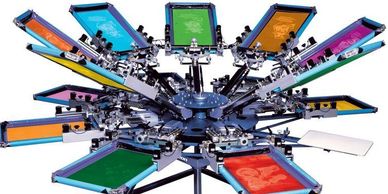IMPRINTING OPTIONS
SCREEN PRINTING
SCREEN PRINTING
SCREEN PRINTING

Screen printing uses fine mesh silk screens along with the best inks in the business to reproduce your artwork. This technique pushes the ink through a woven mesh stencil onto fabric. The ink doesn’t soak into the fabric, it lays on top. Clean, high resolution artwork is crucial for reproduction and Vector format is the most widely used. Fine detailed logos are not recommended using this technique.
Best Choice When You Have:
- Large Quantities
- Needing Vibrant Colors
- Wide Choice of Substrates
EMBROIDERY
SCREEN PRINTING
SCREEN PRINTING

Embroidery offers the highest quality and most durable when branding your business. Fine threads are used to stitch out the logo which can be directly applied to many fabrics, including: cotton, poly, mesh, twill and combinations of all. Special formatting, called digitizing, is needed to convert your logo (.pdf,.jpg,.png) into a digital format for the machine.
Best Choice When You Have:
- Any Quantities
- Outfitting Employees
- Outfitting Teams
- Headwear to Jackets
- Polos
- Name Drops
- Monogramming
DTG
SCREEN PRINTING
DYE SUBLIMATION

Direct to Garment or DTG is a printing method that sprays the ink onto the garment using inject technology. The inks then soak into the fibers of the garment. It's limited to surfaces that will absorb the ink like cotton. Material like polyester can not be used with this method of printing. This process can be equated to printing on sheet fed paper.
Best Choice When You Have:
- Low Quantities
- Fine Detail
- Many Colors
- Working with Photographs
- Printing over zippers, buttons etc.
DYE SUBLIMATION
DYE SUBLIMATION
DYE SUBLIMATION
Sublimation is a chemical process where a solid turns into a gas without going through a liquid stage. Dye sublimation printing is always used on products such as polyester apparel in white or light colors or hard surfaces with a poly-coating, such as coasters, mugs, mouse pads and more. With the sublimation process, the ink becomes part of the fabric as opposed to a layer on top of it. The resulting transfer lasts much longer than heat transfer paper results.
Sublimation can print full colors which is great for transferring images or logos with specific colors.
HEAT TRANSFERS
DYE SUBLIMATION
VINYL TRANSFERS

Heat transfers are a special paper that transfers printed designs onto shirts and other materials when heat is applied. This process involves printing a design onto the sheet of heat transfer paper and using either an inkjet or laser printer. To transfer the design to the fabric, you place the printed sheet on your fabric and press it with a heat press. Once you have pressed it, you can peel away the paper and the image adheres to the fabric. The heat transfer paper process can be used on both cotton and polyester fabrics as well as both dark or light colored fabrics.
Heat transfer paper results in the image creating another layer on top of the fabric. You can feel the additional layer and it can become faded and cracked over time, especially with washing.
VINYL TRANSFERS
DYE SUBLIMATION
VINYL TRANSFERS

Vinyl printing is when a sheet of polyurethane (pu) vinyl is cut to produce a design which is then heat applied to the garments. The below options are also available for non-apparel appilications. Vinyl printing is a method of printing that is generally limited to a 1 color print but multiple colors can be used but, depending on end usage, can be "thick" in feel. The design needs to be "weeded" prior to applying to substrate therefor a detailed logo is not suited for vinyl but can be done. There are many HTV (heat transfer vinyl) options that include:
- Foils & Glitter
- Stretch for performance material
- Flock & Twill
- Refelctive
- Patterned &
- Metallics

